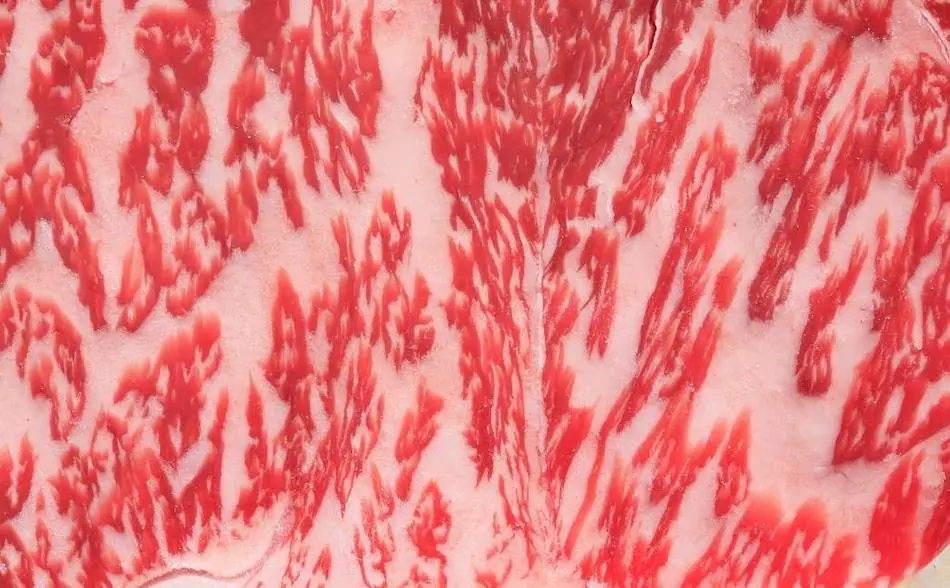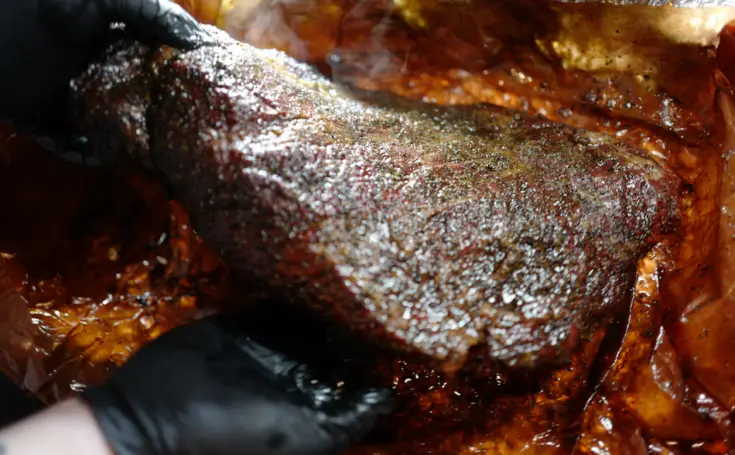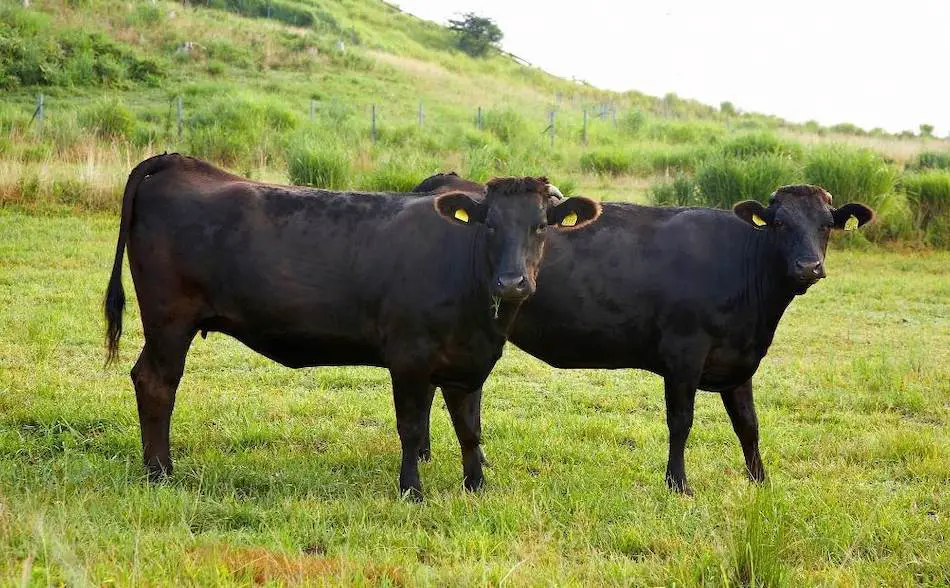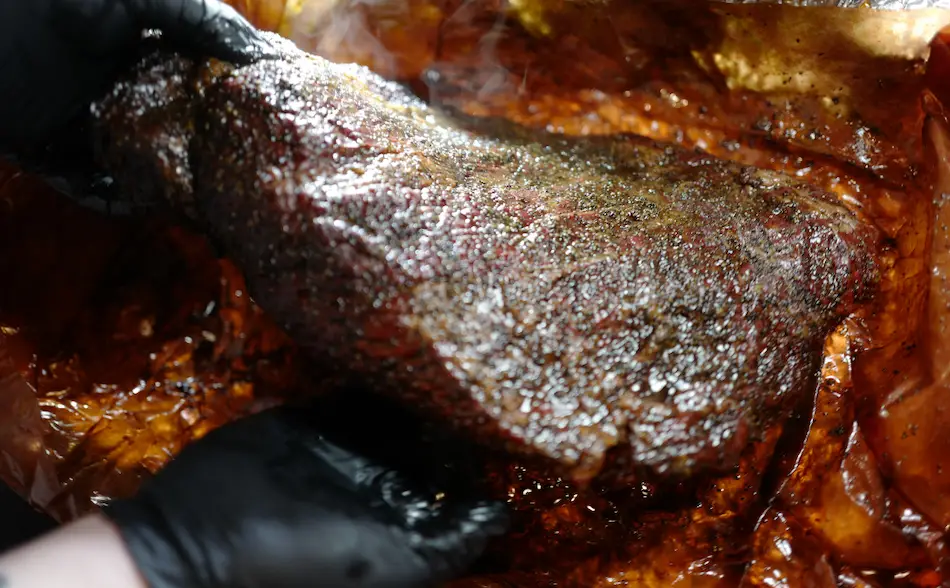
If you’ve managed to get your hands on a wagyu brisket, congratulations. But if you’re going to put it in your smoker, you better know what you are doing. Hopefully, you’ve smoked a few briskets before and have a firm grasp on the fundamentals. However, if you need some more advice before you attempt smoking the world’s most expensive beef, read on because I asked the pros how they smoke wagyu brisket.
Wagyu brisket is best smoked low-and-slow between 225°F and 250°F and lightly seasoned with salt and pepper. To highlight the natural wagyu beef flavor, use barbecue rubs sparingly, and avoid strong flavored smoking woods. Wrap the brisket once the bark has developed, and cook until the internal meat temperature reaches around 200°F, or is probe tender.
| Step | Description |
|---|---|
| 1 | Preheat smoker to 225°F-250°F |
| 2 | Season wagyu brisket lightly with salt and pepper |
| 3 | Place brisket in smoker and cook until bark has developed |
| 4 | Wrap brisket in foil or butcher paper |
| 5 | Continue cooking until internal temperature reaches 200°F or until probe tender |
| 6 | Remove from smoker and let rest for 15-30 minutes before slicing and serving |
Key Points
- Wagyu brisket is known for its high marbling, which helps to keep the meat moist during the long cooking process
- When smoking wagyu brisket, maintain a low and consistent temperature between 225°F and 250°F
- Season the meat lightly with salt and pepper, and avoid using strong flavored barbecue rubs and smoking woods
- Wrap the brisket in foil or butcher paper once the bark has developed to help keep it moist
- Cook the brisket until it reaches an internal temperature of around 200°F or until it is probe tender
- Let the meat rest for at least 15-30 minutes before slicing and serving.
Have you tried smoking a Wagyu brisket yet? You can get one delivered to your door from Snake River Farms.
Smoked Wagyu Brisket

The secret to smoking a wagyu brisket is to highlight the natural flavors. Avoid over-using strong flavored woods or seasonings.
Ingredients
- Wagyu brisket
- Seasoning: Kosher salt and course black pepper, or a barbecue rub.
- A mop sauce or a spritzing liquid such as apple juice, apple cider vinegar or beer.
- Smoking wood
Instructions
1. Trim excess fat from the brisket, leaving 1/4 an inch on the fat cap.
2. Apply the seasoning to the brisket at least two hour prior to cooking. If using salt and pepper, apply an even layer to all parts of the brisket. If using a barbecue rub, don't apply too thick.
3. Set your smoker between 225°F and 250°F. If using a pellet grill, fill the pellet hopper with wood pellets. If using a charcoal smoker, use a thermometer to monitor the temperature of your smoker.
4. Once the smoker has come up to temperature, lay the meat fat side down or towards the heat source. Direct the flat towards the cool-zone.
5. Cook the brisket uncovered. Leave it alone for about 5 hours.
6. Begin spritzing the brisket every hour using a spray bottle filled with either apple juice, apple cider vinegar, or beer. Or, make a mop sauce and mop the brisket with a mop brush.
7. Cook the meat until it reaches an internal temperature of 150°F.. Once the brisket has reached 150°F, begin checking the bark until it is firm and no seasoning sticks to your finger.
8. Once the bark is firm, remove the brisket from the smoker and wrap in aluminium foil or butcher paper.
9. Insert a thermometer probe into the brisket and return to the smoker.
10. Leave the brisket for several hours. Monitor the internal temperature on your thermometer.
11. At this stage, all you are doing is monitoring the internal temperature of the brisket until it reachers the 190*F's. You may increase the temperature of your smoker to push through the stall, but don't go over 275°F. You may also finish the brisket in the oven, but leave the thermometer inserted.
12. The ideal internal temperature for brisket is 203°F. However, begin checking at 195°F for tenderness. once the brisket feels like inserting a toothpick into butter, the brisket has reached perfect tenderness.
Nutrition Information:
Serving Size:
100gAmount Per Serving: Calories: 405Total Fat: 38gProtein: 15g
What Is Wagyu?
The name Wagyu translates to “Japanese Beef”, although not all cattle from Japan is classed as Wagyu. Most Wagyu originates from a superior breed known as Japanese Black, but there are several breeds on the market. Wagyu beef comes from cattle with highly desirable genetics. Four of these Japanese cattle came to America decades ago, and it is these four cattle where wagyu originates. Not all wagyu is of the same quality, which is why there is a meat grading system in Japan. There are hundreds of wagyu brands, but the best and most well known are Kobe Beef, Matsusaka Ushi, and Ohmi Beef.
The Four Wagyu Breeds
There a four breeds of wagyu cattle: The Japanese black, Japanese red ( sometimes called brown), Japanese polled (no horns), and Japanese shorthorn. However, the most common wagyu that you see is from the Japanese black.
| Wagyu Breed | Characteristics |
|---|---|
| Japanese Black | Most common breed in Japan, known for its high marbling and rich, beefy flavor |
| Japanese Brown | Second most common breed in Japan, known for its good marbling and mild flavor |
| Japanese Polled | Rare breed in Japan, known for its high marbling and rich, buttery flavor |
| Japanese Shorthorn | Rare breed in Japan, known for its good marbling and mild flavor |

Different Wagyu Grades
You may have heard beef advertised as A5 Wagyu. Under the Japanese meat grading system, they grade wagyu for yield and quality. Under this grading system, the wagyu is judged for yield and quality. The yield is either A, B, or C, with A being the best yield. They judge the quality with a score between 1 to 5, with 5 being the highest quality. So an A5 Wagyu brisket would be of the highest yield and quality. They grade the quality on the level of marbling (the fatty striations in the meat), the color, the firmness, and the quality of the fat. So the lowest Wagyu grade would be C1 and the best is A5.
| Grade | Yield | Quality Score | Marbling | Color | Firmness | Fat Quality |
|---|---|---|---|---|---|---|
| C1 | C | 1 | Poor | Poor | Poor | Poor |
| C2 | C | 2 | Poor | Poor | Poor | Poor |
| C3 | C | 3 | Poor | Poor | Poor | Poor |
| C4 | C | 4 | Poor | Poor | Poor | Poor |
| C5 | C | 5 | Poor | Poor | Poor | Poor |
| B1 | B | 1 | Poor | Poor | Poor | Poor |
| B2 | B | 2 | Poor | Poor | Poor | Poor |
| B3 | B | 3 | Poor | Poor | Poor | Poor |
| B4 | B | 4 | Poor | Poor | Poor | Poor |
| B5 | B | 5 | Poor | Poor | Poor | Poor |
| A1 | A | 1 | Poor | Poor | Poor | Poor |
| A2 | A | 2 | Poor | Poor | Poor | Poor |
| A3 | A | 3 | Poor | Poor | Poor | Poor |
| A4 | A | 4 | Good | Good | Good | Good |
| A5 | A | 5 | Excellent | Excellent | Excellent | Excellent |
Is Wagyu Good For Brisket?
The highest quality brisket available is a wagyu brisket, due mostly to the high marbling score. Wagyu is famous for its dense marbling, the fatty striations within the muscle, which is highly beneficial for brisket, a tough cut of meat. Brisket needs to be cooked low and slow. If the meat contains no intermuscular fat, the brisket is at risk of drying out. A wagyu grade brisket will remain moist thanks to the dense marbling.
Choosing a Wagyu Brisket
A wagyu the brisket is going to have a lot of intermuscular fat, and marbling which will make the brisket extremely juicy. The high level of intermuscular fat should save the brisket from drying out during the long cooking process. Select a brisket with a thick flat. Also, you want some fat on the brisket to protect the meat from the long cook. However, wagyu is extremely expensive per pound, so you don’t want too much fat. Lightly trim the wagyu, as with other briskets, you want to leave about 1/4 of an inch on the fat cap.

Is Wagyu Unhealthy?
Not only does Wagyu beef taste amazing, it also produces a healthy fat. Wagyu is characterized by its dense inter-muscular fat, or marbling, but wagyu fat is unlike any other fat. Wagyu beef produces an enzyme that converts steric acid (saturated fat) to oleic acid (unsaturated fat).
Why Does Wagyu Taste So Good?
Wagyu has a distinct melt in your mouth velvety texture. This is due to the high level of marbling. Wagyu beef that has also been dry aged enhancers the flavor, especially the tenderness. We all know fat equals flavor, and wagyu is full of fat which is why it has an amazing flavor.
Kobe
Kobe brisket is a name you may have seen at restaurants, and it refers to the popular wagyu brand. Kobe is a city in central Japan most famous for producing some of the world’s best wagyu beef. This amazing breed of wagyu is raised in a stress-free environment to ensure the best quality meat. A pure Kobe wagyu is extremely expensive and very rare. They are easily recognizable because it doesn’t look like the usual red meat. Kobe has so much marbling, that you can hardly see the red meat.
Do Restaurants Serve 100% Wagyu?
The name wagyu is used loosely, and often the wagyu on restaurant menus are only 50% wagyu. Often in America, wagyu is bred with Angus beef. An F1 Wagyu Is 50% Angus and 50% wagyu. Mixing wagyu with Angus is an excellent combination because the Angus will give the meat a nice beefy taste, something that is absent from wagyu.
How To Smoke Wagyu Brisket Like A Scientist
Mad Scientist BBQ approaches barbecue like a scientist. If you’re spending a lot of money to buy a wagyu brisket, you want to make sure you have the cook down to a science. Check out this video to watch Jeremy in action.
Tips For Smoking a Wagyu Brisket
Make sure your smoker is burning a nice clean smoke before you put your prized wagyu brisket onto the grill. The last thing you want is a bad smoke pouring out of your smoker. You’re a nice clean fire, use a nice seasoned smoking wood, and aim for that nice thin blue smoke. Keep your smoker nice and clean, and it might be worth cleaning before your smoke. Dirty smokers equal dirty smoke.
Go Easy On The Rub. When you’re smoking a wagyu brisket, go easy on the rub. You want to enjoy the natural flavors of wagyu beef, without the rub being a dominant flavor. You want the wagyu to be the star of the show. A simple Texas style rub of salt and pepper will be suffice, or perhaps add in a little paprika for color. But whatever you do, hold back on the rub. Be careful with store-bought rubs, because they contain a lot of salt. As most pitmasters will tell you, it’s better to salt your brisket separately.
The Best Wood For Wagyu. Be careful using mesquite on a wagyu brisket. Mesquite will dominate the flavor, so be careful. Hickory can also be a little strong, so use sparingly. I like to use a 50/50 mix of hickory and pecan, or pecan and a fruit with such as apple.
Spritz every 45 minutes while you’re waiting for the bark to set and the fat to render. This is extremely important because you do not want to burn the brisket. So after a few hours, check the brisket every 30 minutes and give it a spray. Continue this until the brisket is wrapped.
Rotate. Once the brisket is wrapped and it is continuing to cook, you may find it will cook unevenly. Using an instant-read thermometer, check the brisket flat and the point. If you find the flat is running cooler, then the point, rotate the brisket so the flat is facing the heat source. Or vice versa. This is a good practise to ensure a nice even cook. If you don’t do this, by the end you may have overcooked the flat even though the point is done to perfection.
How Long Does It Take To Smoke Wagyu Brisket?
A regular brisket can take anywhere from 10 to 18 hours to cook, depending on the size of the meat and the temperature of your smoker. With wagyu beef, the meat will melt at a lower temperature. Approach smoking a wagyu brisket the same way you would a normal brisket. However, a wagyu brisket will be done much faster than your regular brisket.
Have you tried smoking a Wagyu brisket yet? You can get one delivered to your door from Snake River Farms.
The History And Science Of Wagyu Beef
The Bearded Butchers certainly know their meat. If you want to know more about Wagyu, then I would encourage you to watch this video.
Barbecue Rub For Wagyu Brisket
The rub plays an important role with the smoked brisket. The rub helps form the bark, one of the best parts of the smoked brisket. There are dozens of rubs on the market, however many pre-made rubs contain too much salt. This is why I prefer homemade rub recipes. This standard barbecue rub can be used on just about anything and can be adapted to your own taste.
Standard Barbecue Rub

I found this great rub recipe through How To BBQ Right. I use this recipe and alter it slightly depending on what I'm cooking. Made by the guys at Townsend Spice & Supply: https://townsendspice.com/
Ingredients
- - ½ Cup Paprika
- - ½ Cup Salt
- - ½ Cup Sugar
- - ½ Cup Granulated Garlic
- - ¼ Cup Granulated Onion
- - ¼ Cup Chili
- - ¼ Cup Cumin
- - 2 Tablespoons Black Pepper
- - 2 Tablespoons Dry Mustard
- - 1 Tablespoon Cayenne Pepper
Instructions
- Combine all the spices together in a large mixing bowl
- Store rub in rub shakers
My Favorite Brisket Tools
Thanks for checking out this article. I hope you learned a few things. Here are some of my favorite tools I use when smoking brisket that may be useful to you. These are affiliate links, so if you decide to purchase any of these products, I’ll earn a commission. But in all honesty, these are the tools I recommend to my family and friends who are just starting out.
Meat Injector: Injecting meat is a great way to take your barbecue to the next level and help you make competition-style brisket. An injector is the only way you will be able to get flavor and moisture into the middle of the meat. The Beast Injector is a stainless steel injector that is sturdy and affordable. Check the latest price on Amazon here.
Brisket Marinade: The best injection solution on the market is the Butcher BBQ Brisket Injection. This marinade is used in competitions and is made by World Barbecue Champion pitmaster, Dave Bouska. You can find the marinade on Amazon here.
Butcher Paper: Wrapping brisket in butcher paper has become a huge trend in barbeque thanks to Aaron Franklin. Wrapping your brisket in paper will give you a nice brisket bark. However, you can’t just use any old paper, it has to be unwaxed, food grade paper. You can find it on Amazon here.
Brisket Rub: These days I make my own rub when possible, but I always have a few pre-made rubs for when I’m running low. Barbecue guru Malcom Reed produces Killer Hogs, one of the best brisket rubs I’ve found over the years. Another great rub is Slap Yo Daddy, made by brisket master and multiple World Barbecue Champion, Harry Soo.
Meat Thermometer: There are dozens of fancy thermometers on the market, but I still use my trusty TP20. For around $50, I have a high-quality meat thermometer with two probes, and can track the temperature of my smoker with one probe, and my meat with the other probe. The ThermoPro TP20 is an Amazon Best Seller because it’s the easiest thermometer to operate, is durable, highly accurate, and comes with pre-programmed meat settings.
Instant Read Thermometer: Arguably, the second most important tool you need is a fast and accurate instant-read thermometer. These tools play an important role in the latter stages of the cook when the meat needs regular checking in multiple areas. I use the ThermoPro TP19 because it can do everything a ThermaPen can do, but for a fraction of the cost. You can check out the TP19 on Amazon here.
Advanced Thermometer and Automatic Temperature Controller: Once you’re ready to take things seriously, the FireBoard 2 Drive is a six-channel Bluetooth/Wi-Fi thermometer that can monitor up to 6 pieces of meat, control and graph your cook sessions on your smartphone, and attaches to an an automatic blower that will convert your charcoal smoker to a set-and-forget. This is one of the most advanced meat thermometers on the market. You can check it out on the FireBoard website here.
